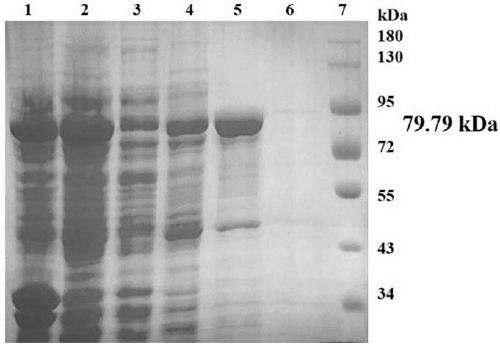Glucomannanase encoding gene and enzyme, preparation and application thereof
A glucomannanase and coding technology, which can be used in application, genetic engineering, plant genetic improvement, etc., can solve the problems of weak degradation activity of konjac polysaccharide and unsuitable for large-scale application.
- Summary
- Abstract
- Description
- Claims
- Application Information
AI Technical Summary
Problems solved by technology
Method used
Image
Examples
Embodiment 1
[0053] Embodiment 1 glucomannanase full-length gene cloning
[0054] Genomic DNA of Klebsiella oxytoca was extracted according to the operating steps of the Genomic DNA Purification Kit (Thermo, LOT 00105781). After performing multiple sequence alignment analysis on the glucomannanase gene sequence in The National Center for Biotechnology Information (NCBI) database, degenerate primers were designed KmanA-F: 5'-GATATACATATGGCGGAGCAGTCGCACTTTGAAC-3'; KmanA-R: 5'- GTATAACTCGAGCTCTGCAACCACTTCAATCG-3', using the extracted genomic DNA of Klebsiella oxytoca as a template, amplifies the gene sequence encoding the mature protein of glucomannanase (excluding the signal peptide gene). The PCR reaction conditions were: 94°C for 2 min, 1 cycle; 94°C for 30 s, 68°C for 30 s (0.5°C drop per cycle), 72°C for 2 min 30 s, 30 cycles; 72°C for 5 min, 1 cycle. PCR products were analyzed by agarose gel electrophoresis (see figure 1 ), the target gene was recovered by gel cutting, connected to th...
Embodiment 2
[0055] Embodiment 2 glucomannanase gene sequence analysis
[0056] The sequencing results were analyzed using Basic Local Alignment Search Tool (BLAST) in the GenBank database, DNAMAN software was used for multiple sequence alignment, and Vector NTI was used to analyze sequence information.
[0057]The coding region of the obtained glucomannanase gene (named KmanA) is 2151 bp long, and its nucleotide sequence is shown in SEQ ID NO 1. KmanA encodes 716 amino acids and a stop codon, its amino acid sequence is shown in SEQ ID NO 2, the theoretical protein molecular weight is 79.79kDa, and the predicted isoelectric point is 5.60. The amino acid encoded by KmanA contains multiple structural domains: a COG3934 superfamily domain, a FN3 (Fibronectin type 3) superfamily domain and a CBM (Carbohydrate Binding Module) 6-CBM35-CBM36_Like superfamily domain. Among them, the COG3934 superfamily domain encodes the endo-β-1,4-mannosidase domain; the FN3 domain has also been reported in bact...
Embodiment 3
[0058] Recombinant expression and purification of embodiment 3 KmanA gene in Escherichia coli
[0059] In order to facilitate the recombinant expression of the gene, NdeI and XhoI enzyme cutting sites were respectively introduced into the designed upstream and downstream primers. The PCR cleaning product KmanA and the expression vector pET21a were double-digested with NdeI and XhoI, respectively, and the digested products were cleaned and recovered, and then used T 4 DNA ligase connection (ligation system: (5μLT 4 DNA Ligase 0.5μL, 10×T 4 DNA LigaseBuffer 0.5 μL, pET21a 2 μL, PCR product 2 μL), ligation conditions: ligate overnight at room temperature. ). Take 5 μL of the ligation product to transform E.coli TOP10 competent cells, spread on solid Luria-Bertani medium containing 100 μg / mL ampicillin, and incubate at 37°C for 12-16 h. Pick a single clone, use degenerate primers for colony PCR verification, insert the correctly amplified single clone into liquid Luria-Bertani...
PUM
| Property | Measurement | Unit |
|---|---|---|
| molecular weight | aaaaa | aaaaa |
Abstract
Description
Claims
Application Information
 Login to View More
Login to View More - R&D Engineer
- R&D Manager
- IP Professional
- Industry Leading Data Capabilities
- Powerful AI technology
- Patent DNA Extraction
Browse by: Latest US Patents, China's latest patents, Technical Efficacy Thesaurus, Application Domain, Technology Topic, Popular Technical Reports.
© 2024 PatSnap. All rights reserved.Legal|Privacy policy|Modern Slavery Act Transparency Statement|Sitemap|About US| Contact US: help@patsnap.com










